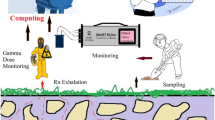Abstract
Purpose
In this study, measurements of radon concentrations and estimation of exhalation rates were carried out in soil around buildings within Lagos State in order to determine the contribution to indoor radon concentrations from the soil, and determine the influence of soil moisture on the exhalation rates.
Methods
Fifty-four samples were collected randomly with 27 measured as wet samples and 27 dried before measurements so as to account for the moisture content. Passive measurement method, using cover cup technique with solid state nuclear track detectors, CR-39, was employed.
Results
The results showed weak correlations between the concentrations of radon emanated from the soil samples and the indoor radon concentrations. The results obtained suggested lower concentrations of radon emanated from wet soil than dry soil indicating the influence of moisture. The results further indicate that the highest and lowest values as well as the highest mean for both wet and dry soil samples were obtained from the same environment, suggesting that the soil in that environment are of anomalous petrophysical property.
Conclusion
Concentrations of radon emanated from dry soil are higher than in wet soil, suggesting that the presence of moisture may results in reduction of radon concentrations in soil samples. The result of the surface exhalation rates and the mass exhalation rates are in congruent with results obtained for the concentrations of radon emanated from wet and dry soil samples.


Similar content being viewed by others
References
Akinloye MK, Abodunrin OP. Radiation exposure in the environment of LAUTECH X-ray Centre: contribution due to the building materials. Nigerian Journal of Science. 2008;42:15–23.
Rehman S. (2005) Radon measurements with CR-39 detectors – implications for uranium ore analysis and risk assessment. PhD thesis. Department of Physics and Applied Mathematics. Pakistan Institute of Engineering and Applied Sciences (PIEAS), Pakistan.
Faheem M, Matiullah. Radon exhalation and its dependence on moisture content from samples of soil and building materials. Radiation Measurements. 2008;43(2008):1458–62 Short communication.
Chauhan RP. Radon exhalation rates from stone and soil samples of Aravali hills in India. Iranian Journal of Radiation Research. 2011;9(1):57–61.
Giles JR, McLing TL, Brandon W, Carpenter MV, Smith CJ. Radon in soil gas above bedrock fracture sets at the Shepley’s hill superfund site. Idaho National Laboratory, Idaho Falls, Idaho. 2012;83415. http://www.inl.gov.
Khalil MT. Determination of radon exhalation rates in soil samples using sealed can technique and CR-39 detectors. J Environ Health Sci Eng. 2018;16:298.
WHO. WHO handbook on indoor radon: a public health perspective. Editors: Hajo Zeeb and Ferid Shannoun; 2010.
Schumann RR, Gundersen LCS, Tanner AB. Geology and occurrence of radon: in radon prevalence, measurement, health risk and control. ASTM Manual Series, MNL. 1994;15:1–8.
Gromicko B. and Gromicko N. (2012) Radon measurement service provider. International Association of Certified Indoor Air Consultants (IAC2). www.IAC2.org
Tanner AB. Radon mitigation in the ground: a review, pp. 161–191. In: Adams JAS, Lowder WM, editors. The natural radiation environment: University of Chicago Press; 1964.
Ferreira AO, Pecequilo BRS, Aquino RR. Application of a “sealed can technique” and CR-39 detectors for measuring radon emanation from undamaged granitic ornamental building materials. Radioprotection. 2011;46(6):S49–54.
HPA (2009) Health Protection Agency. Radon and Public Health. Report of the independent advisory group on ionizing radiation (radon, chemical and environmental hazards). RCE-11.
Guhr A. In a research suggested that passive technique is an effective and reasonable alternative in determining measurement of radon and its decay products. Schriftenr Ver Wasser Boden Lufthyg. 1997;1997:101–143-5 (Article in German).
Ershaidat NM, Al-Bataina A, Al-Rayashi WS. Comparative study of soil radon concentration levels using active and passive detectors. Jordan Journal of Physics. 2015;8(1):29–37.
Alghamdi MAM, Diab H. Measurement of radon content in silty sand soil using RAD7 and CR-39 techniques at Wadi Arar, Saudi Arabia: comparison study. International Journal of Management and Applied Science. 2016;2(5):126–32.
ILSI (2000) International Life Sciences Institute. Report on packaging materials: 1. Polyethylene terephthalate (PET) for food packaging applications. ILSI Europe packaging material task force, 83 avenue E. Mounier, box 6, B-1200 Brussels, Belgium.
Howarth C. J., Miles J. C. H. and Britain G. (2002) Results of the 2001 NRPB intercomparison of passive radon detectors. National Radiological Protection Board.
Trautmannsheimer M. and Körner, S. (2003) Investigation and reduction of personnel radon exposure levels in Bavarian water supply facilities. Proceedings of the 2003 International Radon Symposium - Volume I1. American Association of Radon Scientists and Technologists, Inc. October 5–8, 2003.
Rehman S, Matiullah RS, Rahman S. Studying 222Rn exhalation rate from soil and sand samples using CR-39 detector. Radiat Meas. 2006;41(6):708–13.
Matiullah (2013) Determination of the calibration factor for CR-39 based indoor radon detector. J Radioanal Chem, 298:369–373.
Durranic SA, Ilic R. Radon measurements by etched track detectors. London: World Scientific Publishing; 1997.
Al-Khateeb HM, Alijarrah KM, Alzoubi FY, Alqadi MK, Ahmad AA. The correlation between indoor and soil radon concentrations in a desert climate. Radiat Phys Chem. 2016;130:142–7.
Chen J, Ford KL. A study on the correlation between soil radon potential and average indoor radon potential in Canadian cities. Journal of Environmental Radiaoctivity. 2016. https://doi.org/10.1016/j.jenvrad.2016.01.018.
Benke RR, Kearfott KJ. Accounting for 222Rn loss during oven drying for the immediate laboratory gamma-ray spectroscopy of collected soil samples. Appl Radiat Isot. 2000;52:271–87.
Funding source
This research did not receive any specific grant from funding agencies in the public, commercial, or not-for-profit sectors.
Author information
Authors and Affiliations
Corresponding author
Ethics declarations
This study does not involve human subject
Conflict of interest
None.
Additional information
Publisher’s note
Springer Nature remains neutral with regard to jurisdictional claims in published maps and institutional affiliations.
Rights and permissions
About this article
Cite this article
Abodunrin, O.P., Akinloye, M.K. Determination of radon exhalation rates from soil around buildings in Lagos environments using passive measurement technique. J Environ Health Sci Engineer 18, 129–135 (2020). https://doi.org/10.1007/s40201-020-00446-3
Received:
Accepted:
Published:
Issue Date:
DOI: https://doi.org/10.1007/s40201-020-00446-3




